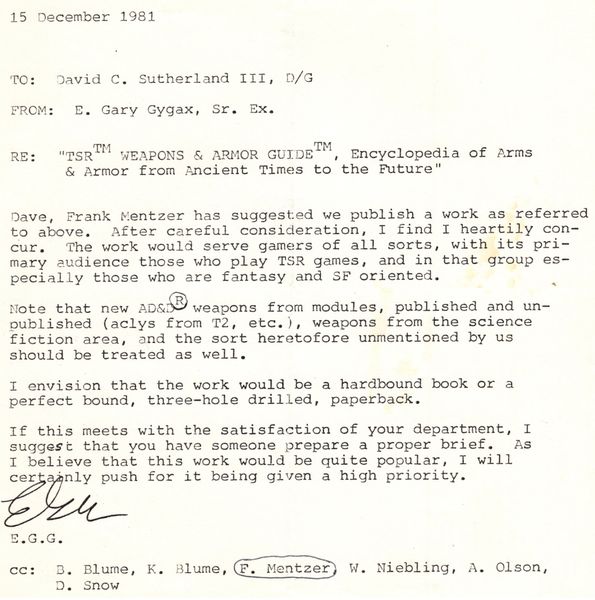Armor, along with the use of a shield,
is the basis for determination of how easily a character can be struck by an opponent's weapon.
Other factors modify this,
of course.
DEX and magical effects are the two
principal modifiers.
Armor, along with the use of a shield,
is the basis for determination of how
easily a character can be struck by an opponent's weapon.
Other factors modify this,
of course.
DEX and magical
effects are the two
principal modifiers.
Do not confuse armor which is worn with
the armor class (AC) rating of a monster.
Although a creature might be given a very
high armor class
because of its exceptionally thick hide,
armor plating,
chitinous exoskeleton,
or the like,
other factors are considered in such ratings.
For example,
the size of the creature,
its SPEED,
its agility,
and perhaps its
supernatural
(extra-dimensional || multi-planed
existence)
aspects are
considered in the AC of
all non-human type monsters.
Therefore,
a monster with an AC of
2 will not be carrying a shield.
Armor types are given on the table below.
Note that the inclusion of a shield raises
armor class (AC) by a factor of 1 (5%),
but that assumes attack from the front
where the character can interpose it between himself and a blow.
-- A small shield can be counted against only one attack per melee round.
![]()
-- A normal-sized shield can effectively
be counted against two attacks per melee round.
-- A large shield is counted against up to three attacks per melee round.
Attacks from the right flank and rear always negate the advantage of a shield.

The cost or armor and shield varies.
Generally speaking, the better the protection,
the greater the expense.
Note: Magic armor negates weight,
so that movement does not consider any encumbrance from magic armor.
There are otherwise various types of magic
armor.
ARMOR CLASS TABLE
ARMOR TYPE
TABLE
| Type of Armor | Armor Class Rating |
| None | 10 |
| Shield only | 9 |
| Leather armor or padded armor | 8 |
| Leather + shield, padded armor + shield, studded leather armor, or ring mail | 7 |
| Studded leather + shield, ring mail + shield, or scale mail | 6 |
| Scale mail + shield, chain mail, or elfin chain mail | 5 |
| Chain mail + shield, elfin chain mail + shield, splint mail, banded mail, or bronze plate mail | 4 |
| Splint mail + shield, banded mail + shield, bronze plate mail + shield, or plate mail | 3 |
| Plate mail + shield or field plate armor | 2 |
| Field plate armor + shield or full plate armor | 1 |
| Full plate armor | 0 |
For each + 1 of magic armor or magic shield,
a decrease in armor class of 1 is given.
For example,
a non-armored character with a + 1 shield
is AC 8,
a +2 shield AC7, etc.
The same is true with regard to pluses
of magic armor of any type.
A +1 converts to a 5% probability. Thus
+2 equals a 10% lesser likelihood of being hit.
Magic plate mail +3 and magic shield +5
are equal to AC -6,
or can be treated as AC 2 with a subtraction
of 8 from attackers' "to hit"dice rolls.
Question: In AD&D,
can a character wear armor over armor?
For example: padded
or leather armor under splint, banded, chainmail or platemail; or even
chainmail under plate-mail?
If this can be done, how
would it alter the armor class?
Answer: No.
The armor (splint, banded,
etc. ) already has parts of lower armor classes built into it.
Therefore, plate mail will
have leather padding (to reduce strain) and chainmail to cover areas not
protected by
the plate. Splint and banded
often have a leather backing. Chain will
have leather padding in
places where the weight of the armor falls.
Without this protection,
heavy armors would soon become uncomfort-
able and painful, as the
metal would chafe and cut the skin. Also,
wearing two layers of armor
would make it very difficult for the character
to bend or move. Armor classes
are not cumulative in this way.
